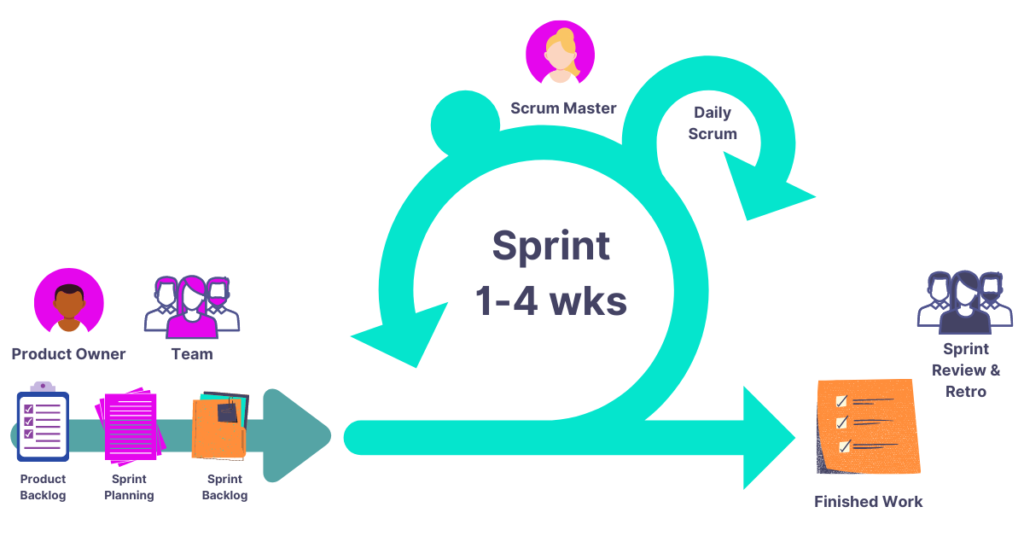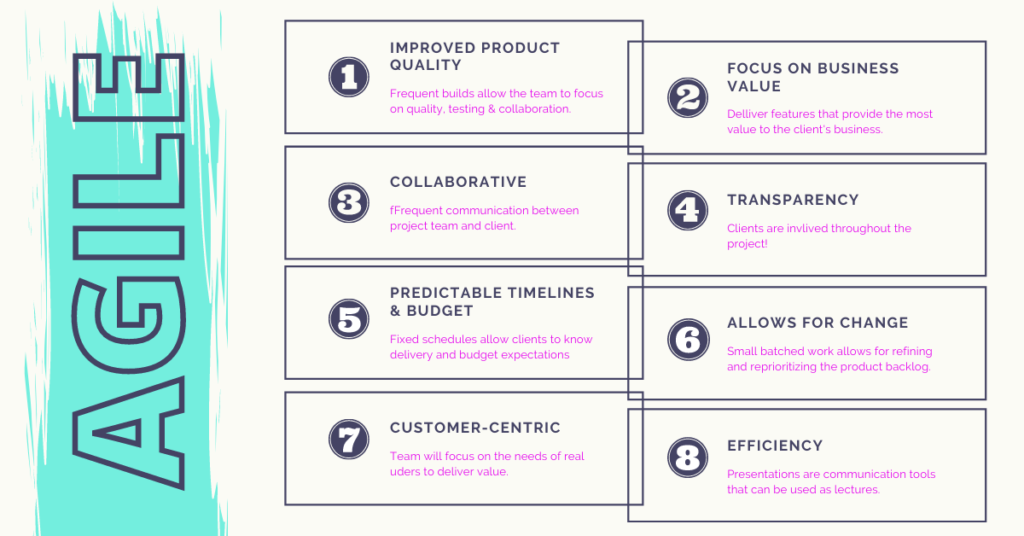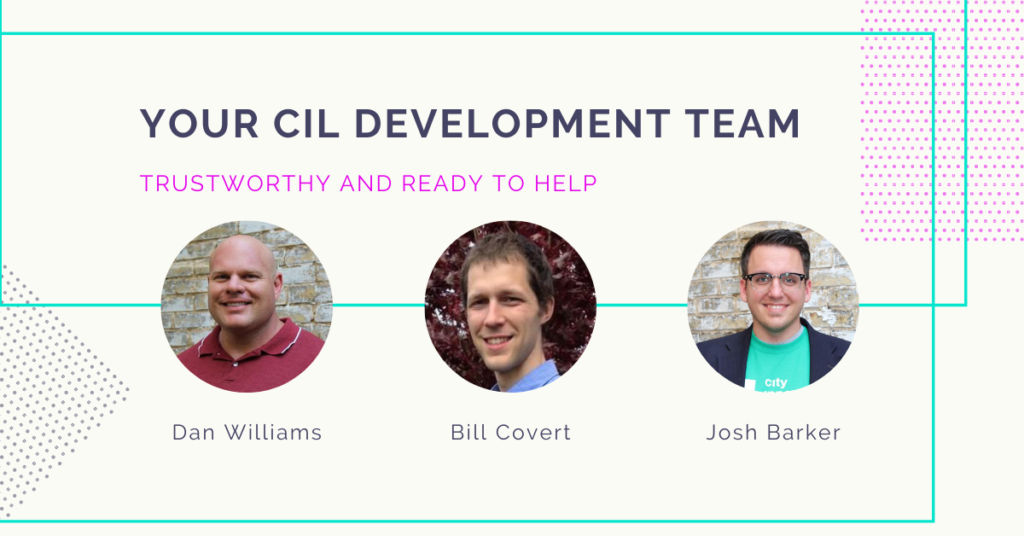Agile Software Development
Agile Software Development is a quick and compelling way to respond to change. It is incremental and iterative and allows for a fast turnaround. Solutions come from collaboration and allow the development process to be customer-centric and proactive to the ever-changing environment.
At City Innovation Labs – we use agile software development because we want to keep our customers informed and part of the process. We found that having constant feedback and getting a product into the hands of our clients quickly was important. Additionally, we know we will continue to make changes throughout the process. This helps us solidify that we’re building a product that the market actually wants.
We are a software company because we believe digital has and will continue to change the world. Companies like Uber, Apple, and Airbnb have changed the way the world does business. We want to help our customers change the world with digital transformation products.
What else can I learn?
Agile Software Development
The Benefits of Agile?
An Explanation of the Agile Methodology
Agile Frameworks
How Can Agile Save You Money?
Why CIL for Agile?
Contact Us
What is Agile Software Development?

Agile Software Development is a methodology that encapsulates iterative development. Solutions evolve through the collaboration of cross-functional teams. The ultimate goal is to deliver value faster. The client gets a product in their hands that they are able to test with their target market to provide invaluable feedback to the development team.
What are the Benefits of Agile Development?
The benefits of agile are numerous and quick to identify. It can benefit everyone within your organization and even those outside of it. How? Check below for the ways agile can impact each role.
Benefits for the Customer

Agile Development is a much more iterative process with shorter feedback cycles. Therefore, the customer is heavily involved. The delivery of the product is quicker with high-value features. This allows for the customer to take on reduced risk and see ROI sooner in the development cycle.
Benefits for the Product Owner
The product manager is responsible for making the customer happy and constantly delivering value. Scrum makes this easier because it provides a frequent opportunity to review work and reprioritize to deliver maximum value. Well defined sprints help the product owner clarify requirements and business value to the team.
Benefits for Project Managers and C-level Stakeholders
As a project manager, you are looking to get things done as quickly and efficiently as possible. There are a lot of moving parts and getting everyone organized is a constant battle. Agile helps with that by making planning more concrete. The PM knows where the project is at all times. The large project is broken down into more manageable pieces that are tackled through iterations or sprints. You can target incrementally and planning and tracking can be more concrete.
The PM has awareness about the state of the project at all times. Large projects are broken down into smaller chunks that are tackled in iterations or sprints. Working in small sprints allows the team to move fast and get something into the hands of customers even faster. Constantly reviewing the project allows the PM to know if the customer is satisfied and the team is moving in the right direction.
Benefits for Development Teams
Agile development is beneficial for development teams because it allows architects to work directly with the client. Teams are constantly receiving feedback on what is being built and therefore they are able to iterate quickly and make changes the customer wants in real time. They are able to successfully hand off the product to the customer knowing that they built something that is wanted and needed. They also gather feedback from the end user and know that what they built will be used. The product can evolve over time as they find out what the target marketing is looking for and as such – the development of the product can adapt more efficiently.
What is Agile Methodology?
Agile Methodology encapsulates a common mindset to always be delivering value. With roots in nimble and transparent practices, Agile allows teams to move and gather feedback quickly. Using incremental, iterative working sequences called sprints, teams are able to make decisions and get buy-in from customers before building out new features. The agile methodology believes in 4 things:
- Individuals and interactions over processes and tools
- Working software over comprehensive documents
- Customer collaboration over contract negotiation
- Responding to change over following a plan
Agile Frameworks
Agile Frameworks are part of the overall Agile Methodology. Each organization approaches how they do agile development differently and therefore different frameworks have developed with their own iterative processes. You’ll find explanations of the most popular of these below.
While we understand all of these frameworks, CIL typically uses the Scrum framework as it is the most intuitive for our team.
Scrum
We use a Scrum framework at CIL. This means we work in short-term blocks called sprints. These are usually 1-2 week intervals. The ScrumMaster and Product Owner oversee the self-organized Scrum team. The ScrumMaster is the team guide. The Product Owner is the liaison between the business and the customers.
Scrum is easy to understand and allows for rapid feedback. Scheduling daily meetings help identify any issues or blockers slowing down the team. Scrum is the ideal choice if your team has an organic approach to decision making. This method isn’t as suitable for a top-down management approach. We have a small development team, so scrum works for us because it allows us to be quick on our feet.
Extreme Programming (XP)
Extreme programming emphasizes the broader philosophy of Agile. It produces higher quality software to please customers and makes life better for the engineers developing it. The main characteristics include dynamically changing software requirements, using a small extended development team, and leveraging technology that facilitates automated unit and functional tests. XP can help cut costs for software development teams. Team members are accountable to the team for their work and the emphasis on quality of life issues helps boost team morale.
XP has 5 Core Values: communication, simplicity, feedback, courage, and respect.
The XP framework believes in face to face communication in order to solve problems quickly. Keep it simple, what is the simplest thing that will work? Constantly provide feedback on previous work to identify areas for improvement. Have the courage to challenge inefficiencies and organizational deficiencies, try something new, or stop doing something that isn’t working. Respect each other in order to communicate and work in tandem.
Kanban
Kanban is a lean method to manage and improve work across systems. This framework manages work by balancing demands with available capacity and handles system-level bottlenecks. Kanban requires real-time communication of capacity and full transparency of work. The Kanban board is a visual representation of the state of every piece of work at any time. This process matches the amount of work in progress to the team’s capacity. It allows for more flexible planning options, faster output, clearer focus, and transparency throughout the dev cycle. The Kanban board should be a single source of truth for the team’s work.
The Kanban team focuses only on the work that is actively in progress. The product owner is free to prioritize as they need to. We typically do not use Kanban at CIL, however, we have used it as a visual tool to view sprints in progress.

How Can Agile Save Your Business Money?
Saving money is key in a development process. Throwing a lot of money at a bad product is every businesses nightmare. When you use Agile, simplicity is key. The end goal is a development of an MVP that has all the valuable features and none of the waste.
Agile is iterative and collaborative, meaning that all the imperative people are in the room making decisions about the product. The team is able to identify the most valuable features and eliminate any that don’t fit those qualifications. The iterative nature of Agile Development is a huge benefit over Waterfall development because you are able to minimize waste and uncertainty early in the process. The team is constantly asking for feedback on iterations which means that the morale of the project is high because of the collaboration between the customer and the development team.
Agile provides the benefit of working in quick cycles or sprints. While it may not be any faster than waterfall – it will deliver fast results along the way. Without understanding the full product at the beginning, waterfall is a hard concept. Agile Development fits best when you need to learn what features are needed. It’s easier to change and create the product as you work.
Saving money is inherent with Agile because you are no longer developing features that are wasteful or don’t impact the value of the project. You are strictly developing a product that will be valuable to your customers and proving it along the way.
Why Choose City Innovation Labs as YOUR Agile Software Development Company?
We are customer-centric! What does that even mean? It means we value people over process. We are going to meet with you. We are going to brainstorm with you. You, as the client, will be involved the entire time. Collaboration is key – we want to know what is important to you and we’ll figure out how to get you there. We work diligently to make sure we are constantly delivering value and creating a product that your customers want to use, that helps you be more efficient, or that can help scale your company in an innovative way.
We have an agile process which means we won’t show you the entire process upfront. Instead, each week we’ll show you working software. We’ll work through the project to make it budget-friendly and efficient. CIL relies on flexibility in the creation of your product and the features, which allows us to monitor the market and adapt as needed.
The biggest difference working with CIL versus other software development firms is our dedication to not only an Agile methodology but a lean startup slant as well. Before we build it – we are going to work with you to make sure your product is going to stand out in the marketplace. We’re going to make sure it’s right. Trust is so important in a process like this and we’ve got your back.
Our Agile Software Dev Team





